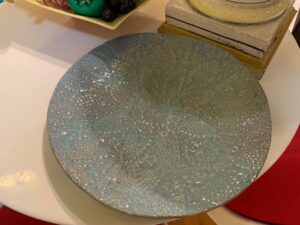 An artist in Montecito received a gift of a unique ceramic charger plate found at a thrift store in Goleta. It’s signed ‘M Arntz.’ She wrote about the blue glaze with a delicate shading of beige on a textured surface, a work of art. Indeed. Michael Arntz, a local hero in the world of Southern California modern design and crafts, and a UCSB Professor Emeritus of Art did this piece. He created work in many mediums such as clay, fiberglass, and paint, for many different causes, sites, and exhibitions.
An artist in Montecito received a gift of a unique ceramic charger plate found at a thrift store in Goleta. It’s signed ‘M Arntz.’ She wrote about the blue glaze with a delicate shading of beige on a textured surface, a work of art. Indeed. Michael Arntz, a local hero in the world of Southern California modern design and crafts, and a UCSB Professor Emeritus of Art did this piece. He created work in many mediums such as clay, fiberglass, and paint, for many different causes, sites, and exhibitions.
Large-Scale Arntz Sculptures in Montecito Gardens Today
He’s a seminal figure in the California Design Movement of the 1960-70s with a forceful approach to large-scale work. When I looked at some of the ceramic sculptures recently sold the appearance of strength struck me. Not to mention the values achieved. A large eighty-five inch sculpture on a stand created in 1970 sold at Bonhams for $3,500 in 2011. At Los Angeles Modern Auctions in 2008 a monumental garden sculpture done in 1966 sold for $10,000. That piece bears the same eerie blue glaze as does the charger given to the artist. Arntz’s pressed his Danish grandmother’s embroidery into the clay for texture.
These works sold embody strength and forcefulness of design. Arntz took advantage of UCSB’s large ceramic studio. He threw seventy-five pounds of clay on a potter’s wheel with ease. In fact, few potters can lift that much clay let alone manipulate that mass while spinning. Arntz’s unique background as a former linebacker and a wrestler helped him retain that handsome athletic physique.
Athlete to Artist
His July 2020 obituary in the Independent lists his athletic achievements. His private life echoes his works’ keynotes. He began as an athlete in Oklahoma, playing football as a linebacker and pulling guard. Santa Monica Junior College recruited him in 1958 where he went on to play for the National Championship Team. He then achieved a football scholarship to attend Long Beach State University (BA 1962). There he discovered large kilns and stayed on for an MFA (1964).
In 1965 Alfred Moyer recruited Arntz for the UCSB department of art, famous for its innovative creators and equipment, and indoor-outdoor ceramic facility. Arntz taught at UCSB for 38 years, and married UCSB alum and artist Penny Schuchman Arntz, whom I interviewed for this article. He served as Chair of the Department of Art from 1981 to 1987. Always close to open spaces, he received a 1986 NEA Commission for Art Installations in National Parks.
Arntz Became Professor Emeritus in 2003
During years prior, he developed a passion for nature photography for an important reason. He became aware of the UC’s management of their Nature Preserve Sites throughout California. At UCSB’s request he became a documentary photographer, using the lens to persuade and advocate for the proper custodianship of these lands. In other words, not to subdivide and make money. He developed a commitment to Sedgwick Reserve in the Santa Ynez Valley, unoccupied for years at the time. He brought the positive energy of his creativity as a force in preservation of the landscape. An exhibition entitled Science and Spirituality at the Santa Barbara Museum of Natural History presented his large-scale photographs of the nature reserve on Santa Cruz Island as an interactive exhibition, soliciting viewers’ commentary on what they saw.
Arntz said, “The message of hope and healing has been and will continue as the fundamental force behind my creative endeavor. The only true factor in the future of our presence on this planet can be derived from such a positive energy and attitude.” I found a strong connection to Native American philosophy and design in his work. In fact, in 1968 he won the Pearl Chase Fund Award for his Research in Ethnic Arts and Artifacts.
Fun Fact About Arntz’ Work in Santa Barbara
You see his work every time you drive past State and La Cumbre. He received the Louis Comfort Tiffany Award for research and creativity in ceramics, notably sculpture in an architectural environment. This abiding interest led to a commission by Barry Berkus for his ‘Galleria’ for architectural ceramic tiles surmounting the four columns below the pediment, geometric shapes in matt brown on black. Gryphon Capital renovated the building in 2017. Today that pediment bears a red Target logo and those tiles are accented with reds, yellows, and gold gilding, leaving some areas matte black.
This great thrift store find is appraised at $800.